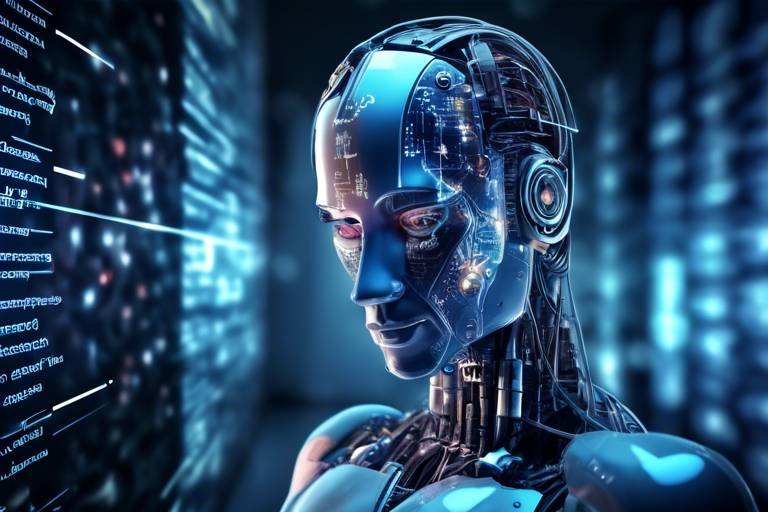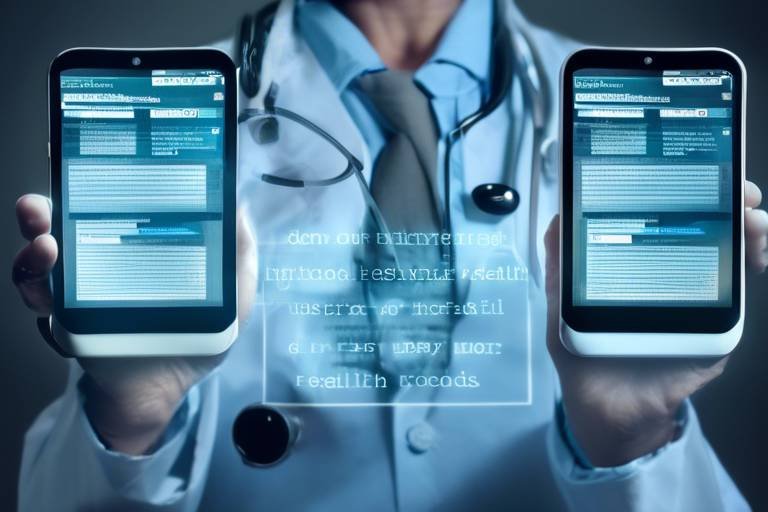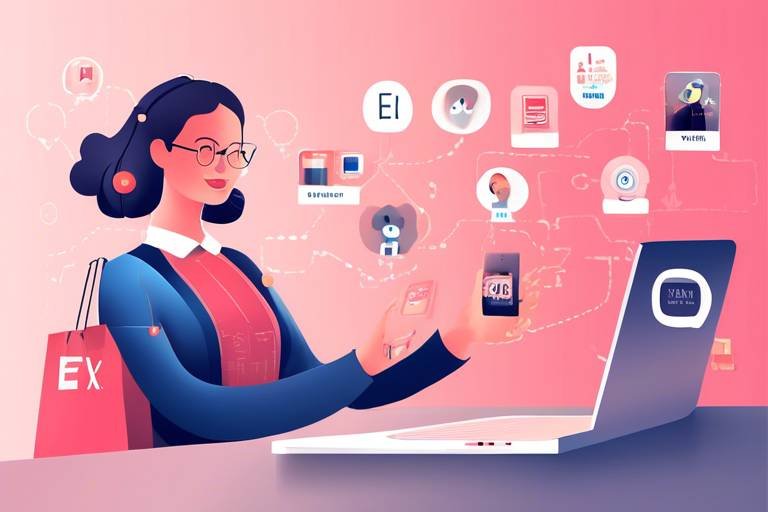How Technology is Changing the Food Industry
In today's fast-paced world, the food industry is undergoing a remarkable transformation, largely driven by technological advancements. From the way we grow our crops to how we shop for groceries and even what we eat, technology is reshaping every aspect of the food chain. Imagine a world where robots harvest crops, drones deliver your groceries, and apps provide personalized meal suggestions based on your dietary preferences. Sounds futuristic, right? Well, it's happening now! This article delves into the various innovations that are revolutionizing the food industry, making it more efficient, sustainable, and consumer-friendly. So, buckle up as we explore this exciting journey!
Automation is revolutionizing food production, enhancing efficiency and reducing labor costs. With the integration of robotics and artificial intelligence (AI), tasks that once required human hands are now being performed by machines. For instance, consider the process of harvesting fruits and vegetables. Robots equipped with advanced sensors can identify ripe produce and pick them without damaging the plants. This not only speeds up the harvesting process but also ensures consistency in quality. Additionally, AI algorithms are optimizing food processing by predicting maintenance needs, thereby minimizing downtime and increasing productivity. The result? A more streamlined production line that meets the ever-growing demand for food.
Welcome to the era of smart farming, where technology meets agriculture! By employing Internet of Things (IoT) devices and data analytics, farmers can now optimize crop yields like never before. Imagine having sensors in your fields that monitor soil moisture, temperature, and nutrient levels in real-time. Farmers can make informed decisions based on this data, adjusting irrigation and fertilization to maximize productivity while minimizing waste. This not only boosts crop yields but also promotes sustainable practices. As a result, smart farming is paving the way for a greener future, ensuring we can feed a growing population without exhausting our natural resources.
When it comes to food, safety is paramount. Technological advancements are significantly improving food safety protocols, ensuring that the food we consume is safe and healthy. With the introduction of traceability systems and real-time monitoring, it has become easier to track food from farm to table. For example, if a contamination issue arises, these systems can quickly identify the source, allowing for swift action to prevent further spread. Additionally, IoT devices can monitor storage conditions, alerting businesses to any deviations that could compromise food safety. In essence, technology is creating a safer food environment for consumers, giving us peace of mind with every bite.
The rise of e-commerce has transformed grocery shopping into a convenient and efficient experience. Gone are the days of wandering through crowded aisles with a shopping cart. Now, you can browse your favorite items from the comfort of your home and have them delivered right to your doorstep. This shift in consumer behavior has prompted businesses to adapt quickly, investing in user-friendly online platforms and mobile apps. As a result, consumers enjoy personalized recommendations, easy price comparisons, and even the ability to schedule deliveries at their convenience. The food shopping experience has never been more tailored to individual needs!
Innovations in delivery and logistics are reshaping how food reaches consumers. Imagine ordering your favorite meal and having it delivered by a drone in minutes! This is becoming a reality as companies explore advancements in supply chain management. By utilizing optimized routing software, businesses can ensure that deliveries are made efficiently and on time, reducing costs and minimizing environmental impact. Furthermore, automation in warehouses is speeding up order fulfillment, allowing for faster delivery times. The future of food delivery is not just about speed; it's also about reliability and sustainability.
As concerns about sustainability rise, technology is driving the development of plant-based and lab-grown foods. These innovations are not only addressing environmental issues but also catering to changing dietary preferences. For instance, lab-grown meat is produced using cellular agriculture, which significantly reduces the need for land and water compared to traditional livestock farming. Meanwhile, plant-based alternatives are becoming increasingly popular, offering delicious options that appeal to both vegans and meat-lovers alike. This shift not only benefits our health but also contributes to a more sustainable food system.
Mobile applications are enhancing consumer engagement in the food industry like never before. With the power of technology at our fingertips, apps are being used for personalized marketing, loyalty programs, and even feedback collection. Imagine receiving tailored meal suggestions based on your previous orders or earning rewards for trying new dishes. These interactive experiences not only foster a connection between consumers and brands but also encourage a more personalized approach to food choices. In a world where options are endless, these apps help consumers navigate their choices with ease and excitement.
Blockchain technology is increasing transparency in food supply chains, offering a revolutionary way to track food origins and ensure accountability in sourcing and distribution. By recording every transaction in a secure and immutable ledger, stakeholders can trace the journey of food products from farm to table. This is particularly crucial in times of food safety crises, as it allows for quick identification of contaminated products. Moreover, consumers are becoming more conscious about the origins of their food, and blockchain provides a way to verify claims about sustainability and ethical sourcing. The result is a more trustworthy food system that benefits everyone involved.
The future of food technology is promising and dynamic, with emerging trends and innovations poised to further revolutionize the industry. From advancements in artificial intelligence that predict food trends to the rise of augmented reality in dining experiences, the possibilities are endless. As we look ahead, we can expect to see more sustainable practices, personalized nutrition plans, and even greater integration of technology in our daily food experiences. The food industry is on the brink of a transformation that will not only change how we eat but also how we think about food itself.
- How is technology improving food safety? Technology enhances food safety through real-time monitoring and traceability systems, allowing for quick identification of contamination sources.
- What role does automation play in food production? Automation streamlines processes in food production, increasing efficiency and reducing labor costs through robotics and AI.
- How are consumer preferences changing with technology? Technology enables personalized shopping experiences, making it easier for consumers to find products that match their dietary needs and preferences.
- What are the benefits of plant-based and lab-grown foods? These foods address sustainability concerns and cater to changing dietary preferences while reducing the environmental impact of traditional farming.

Automation in Food Production
Automation is not just a buzzword; it’s a game changer in the food production sector. Imagine walking into a farm where robots are tirelessly planting seeds, monitoring crop health, and even harvesting ripe fruits and vegetables. This is the reality of modern agriculture, where technology and innovation are enhancing efficiency and drastically reducing labor costs. By integrating robotics and artificial intelligence (AI) into food production, we are witnessing a transformation that not only boosts productivity but also addresses the growing demand for food.
One of the most exciting aspects of automation is its ability to streamline processes. For instance, consider the traditional methods of farming, which often relied heavily on manual labor. Now, with the introduction of automated machinery, tasks like planting, watering, and fertilizing can be done with precision and speed. This not only minimizes human error but also ensures that resources are utilized efficiently. The result? Higher yields and lower costs. It’s like having a super-efficient team that never tires!
Moreover, the integration of AI in food processing is revolutionizing how we handle food post-harvest. AI systems can analyze vast amounts of data to optimize processing times and improve quality control. For example, machine learning algorithms can predict spoilage rates and adjust processing schedules accordingly, ensuring that food products are always fresh and safe for consumption. This level of precision is crucial in today’s fast-paced market, where consumers expect nothing less than perfection.
To illustrate the impact of automation, let’s take a look at a simple comparison:
| Traditional Farming | Automated Farming |
|---|---|
| High labor costs | Reduced labor costs |
| Inconsistent yield | Consistent and higher yield |
| Manual monitoring | Real-time monitoring with sensors |
| Slow processing times | Optimized processing with AI |
As we embrace these technological advancements, it’s essential to consider the implications for the workforce. While automation does reduce the need for manual labor, it also creates new opportunities in tech-driven roles. Workers will need to adapt, learning how to operate and maintain these sophisticated machines. This shift may seem daunting, but it’s also an exciting opportunity for growth and innovation within the industry.
In conclusion, automation in food production is not just about replacing human labor; it’s about enhancing our ability to produce food sustainably and efficiently. As we continue to innovate and integrate new technologies, the future of food production looks not only promising but also revolutionary. Who knows what the next big breakthrough will be? It’s a thrilling time to be involved in the food industry!
Q: What are the main benefits of automation in food production?
A: The main benefits include increased efficiency, reduced labor costs, consistent yields, and improved quality control.
Q: Will automation replace human jobs in the food industry?
A: While automation may reduce the need for certain manual labor jobs, it will also create new opportunities in tech-driven roles that require different skill sets.
Q: How does AI contribute to food processing?
A: AI helps optimize processing times, predict spoilage rates, and improve overall quality control by analyzing data in real-time.

Smart Farming Techniques
In today's fast-paced world, smart farming is not just a trend; it's a necessity. With the global population skyrocketing and climate change wreaking havoc on traditional farming methods, farmers are turning to innovative technologies to optimize their crop yields and ensure sustainability. Imagine a farm where every plant is monitored in real-time, where data analytics guide every decision, and where the efficiency of production is maximized. This is the reality of smart farming, and it’s changing the way we grow food.
At the heart of smart farming are Internet of Things (IoT) devices. These nifty gadgets collect data from the field, such as soil moisture levels, temperature, and humidity. By utilizing sensors placed throughout the farm, farmers can gain insights that were previously impossible to obtain. For example, a sensor might alert a farmer that certain crops are thirsty, allowing them to irrigate only where needed. This not only conserves water but also promotes healthier plants.
Moreover, data analytics plays a crucial role in smart farming. By analyzing historical data and current conditions, farmers can predict outcomes and make informed decisions. For instance, if data shows that a particular crop thrives in specific weather conditions, farmers can plan their planting schedules accordingly. This predictive capability helps in maximizing yield and minimizing waste. It’s like having a crystal ball that tells you the best time to sow your seeds!
One of the most exciting aspects of smart farming is the use of precision agriculture. This technique involves using technology to monitor and manage field variability in crops. By applying the right amount of inputs (like fertilizers and pesticides) at the right time, farmers can enhance productivity while reducing environmental impact. In fact, studies have shown that precision farming can increase crop yields by up to 20% while significantly cutting down on resource use.
Additionally, smart farming isn't just about the technology used; it's also about the data-driven decisions that come from it. Farmers are now able to utilize drone technology for aerial imagery and analysis. Drones can survey large areas of farmland quickly, identifying problem areas that need attention. With this information, farmers can take action before small issues escalate into larger problems, saving both time and money.
To illustrate the impact of smart farming, consider the following table that summarizes the key benefits:
| Benefit | Description |
|---|---|
| Increased Efficiency | Smart farming technologies streamline operations, reducing labor costs and time. |
| Resource Conservation | Precision agriculture optimizes the use of water, fertilizers, and pesticides. |
| Higher Yields | Data-driven decisions lead to improved crop health and productivity. |
| Real-time Monitoring | IoT devices provide continuous feedback on crop conditions. |
As we look to the future, the potential of smart farming techniques is vast. By embracing these technologies, farmers can not only increase their profitability but also contribute to a more sustainable food system. It's a win-win situation! So, next time you bite into that juicy tomato or savor a fresh salad, remember the incredible technology that helped bring that food to your table. It's a fascinating world out there, and smart farming is at the forefront of it all!
- What is smart farming? Smart farming refers to the use of technology and data analytics to optimize agricultural production and resource management.
- How does IoT improve farming? IoT devices collect real-time data from the field, allowing farmers to make informed decisions about irrigation, pest control, and crop management.
- What are the benefits of precision agriculture? Precision agriculture enhances resource use efficiency, increases crop yields, and reduces environmental impact.
- Can drones be used in farming? Yes, drones are used for aerial surveys, crop monitoring, and even targeted pesticide application.

Food Safety Innovations
In today’s fast-paced world, where food travels from farm to table faster than ever, food safety has become a paramount concern. With technological advancements, the food industry is seeing a remarkable transformation in how we ensure that the food we consume is safe and free from contamination. Innovations in food safety are not just about compliance; they are about building trust with consumers and ensuring that every bite is as safe as it is delicious.
One of the most significant advancements in food safety is the implementation of traceability systems. These systems utilize barcodes and RFID technology to track food products throughout the supply chain. Imagine being able to trace a piece of lettuce back to the exact farm it was harvested from! This level of transparency is not only reassuring for consumers but also critical for businesses to quickly address any potential safety issues. In the event of a foodborne illness outbreak, traceability allows for swift action, minimizing health risks and financial losses.
Moreover, real-time monitoring technologies are revolutionizing how we manage food safety. Sensors placed in storage facilities and transportation vehicles can monitor temperature, humidity, and other conditions that affect food quality. For example, if a shipment of seafood is transported in a truck that exceeds safe temperature limits, alerts can be sent instantly to prevent the food from reaching consumers. This proactive approach is a game-changer, allowing companies to act before problems escalate.
Another exciting innovation is the use of artificial intelligence (AI) in food safety protocols. AI algorithms can analyze vast amounts of data to identify patterns and predict potential safety risks. For instance, by analyzing historical data on foodborne illnesses, AI can help determine which products are at higher risk of contamination and suggest preventive measures. This predictive capability is akin to having a crystal ball for food safety, enabling companies to stay one step ahead of potential threats.
In addition to these technologies, the rise of mobile applications is also playing a crucial role in enhancing food safety. Many consumers now have access to apps that provide information about food origins, safety ratings, and even cooking tips to minimize contamination risks at home. This level of engagement empowers consumers to make informed choices about what they eat. In fact, a recent study found that consumers are more likely to trust brands that are transparent about their food safety practices, making these innovations beneficial for both consumers and businesses.
As we look to the future, it’s clear that the food industry is on the brink of a safety revolution, driven by technology. The integration of blockchain technology is another exciting development that promises to enhance food safety. By creating a decentralized and immutable record of every transaction in the food supply chain, blockchain ensures that all parties involved are accountable for their products. This level of accountability is crucial in preventing fraud and ensuring that food safety standards are met consistently.
In conclusion, the innovations in food safety are not just about keeping up with regulations; they are about creating a safer food environment for everyone. With technologies like traceability systems, real-time monitoring, AI, and blockchain, we are witnessing a transformation that prioritizes consumer health and safety. As these technologies continue to evolve, we can expect even greater advancements that will further enhance our ability to enjoy food with confidence.
- What are traceability systems? Traceability systems track food products throughout the supply chain using barcodes and RFID technology, allowing for quick identification of sources in case of contamination.
- How does real-time monitoring improve food safety? Real-time monitoring uses sensors to track conditions like temperature and humidity during transportation, alerting companies to potential safety risks before they escalate.
- What role does AI play in food safety? AI analyzes data to predict potential safety risks and suggests preventive measures, helping companies stay ahead of foodborne illness outbreaks.
- How can consumers ensure food safety at home? Consumers can use mobile apps to check food origins and safety ratings, as well as follow safe cooking practices to minimize contamination risks.

Online Grocery Shopping
In recent years, has surged in popularity, fundamentally altering the way we procure our daily essentials. Gone are the days when we had to brave the aisles of a crowded supermarket, pushing a cart filled with items while dodging fellow shoppers. Now, with just a few clicks, you can have your groceries delivered right to your doorstep. But what has spurred this transformation? Let's dive into the factors that are reshaping our shopping habits.
One of the most significant drivers of this change is the advent of technology. With the rise of smartphones and high-speed internet, consumers can access a plethora of online grocery platforms from the comfort of their homes. Whether it’s big-name retailers or local farmers' markets, the options are endless. This convenience is not just about saving time; it’s about creating a shopping experience that is tailored to individual preferences. Imagine being able to create a shopping list, compare prices, and read reviews all in one place! That’s the beauty of online grocery shopping.
Moreover, the COVID-19 pandemic accelerated this trend, forcing many to adapt to new shopping behaviors. As people became more health-conscious and wary of crowded spaces, online grocery shopping emerged as a safe alternative. Retailers quickly adapted by enhancing their digital platforms, offering contactless delivery options, and even implementing innovative solutions like click-and-collect services. These changes not only catered to immediate needs but also set a new standard for customer expectations.
But what does this mean for the food industry? For businesses, it presents both challenges and opportunities. Traditional grocery stores have had to rethink their strategies, investing heavily in their online presence and logistics to keep pace with e-commerce giants. This has led to a significant shift in the supply chain, requiring more efficient inventory management and faster delivery systems. In fact, many retailers are now utilizing advanced data analytics to predict consumer demand and optimize their stock levels.
Interestingly, online grocery shopping is also reshaping consumer behavior. Studies indicate that shoppers are more likely to experiment with new products when shopping online compared to in-store. This can be attributed to the ease of browsing and the plethora of recommendations available at their fingertips. For instance, many platforms now employ algorithms that suggest items based on past purchases, making it easier for consumers to discover new favorites.
As we look to the future, the evolution of online grocery shopping shows no signs of slowing down. With the integration of artificial intelligence and machine learning, we can expect even more personalized shopping experiences. Imagine a future where your grocery app knows your dietary preferences and automatically generates a shopping list for you! The possibilities are endless, and they’re exciting.
In conclusion, online grocery shopping is more than just a trend; it’s a revolution in the food industry that is here to stay. As technology continues to innovate, we can anticipate a shopping experience that is not only efficient but also engaging and tailored to our individual needs. So, the next time you click ‘checkout’ from your couch, remember that you’re part of a larger movement that’s changing how we think about food procurement.
- Is online grocery shopping more expensive than in-store shopping? It can vary. While some items may be marked up, many online platforms offer competitive prices and discounts.
- How do I ensure the freshness of my groceries when ordering online? Choose reputable retailers that prioritize quality and offer satisfaction guarantees. You can also read reviews and check ratings.
- Can I return items if I’m not satisfied with my online grocery order? Most retailers have return policies in place, but it’s best to check the specific terms of the store you’re purchasing from.

Delivery and Logistics Technology
In today's fast-paced world, the way we receive our food has undergone a remarkable transformation, thanks to advancements in . Imagine a scenario where your favorite meal is not only a click away but can also arrive at your doorstep in record time. This isn't just a dream anymore; it's a reality driven by innovative solutions that are reshaping the food delivery landscape.
One of the most exciting developments in this field is the integration of artificial intelligence (AI) and machine learning into logistics systems. These technologies allow companies to analyze vast amounts of data, optimizing delivery routes and reducing wait times for consumers. For example, AI algorithms can predict traffic patterns, weather conditions, and even customer preferences, ensuring that food is delivered efficiently and hot off the stove.
Moreover, the rise of drone deliveries is another game-changer. Picture this: a drone zipping through the sky, carrying your groceries or a piping hot pizza. Companies like Amazon and various startups are exploring this technology, which promises to cut down delivery times significantly. However, while the idea sounds futuristic, there are still regulatory and technical hurdles to overcome before we see widespread adoption.
Another key aspect of modern logistics is the use of smart warehousing. This involves automated systems that manage inventory and streamline the packing process. With the help of robots, warehouses can operate more efficiently, ensuring that orders are fulfilled quickly and accurately. The result? Less time spent waiting for your food and more time enjoying it!
To illustrate the impact of these technologies, consider the following table that highlights some of the key innovations in delivery and logistics:
| Technology | Description | Benefits |
|---|---|---|
| AI Routing | Utilizes data to optimize delivery paths | Reduces delivery times and costs |
| Drone Delivery | Airborne delivery systems for faster service | Minimizes traffic delays, quick delivery |
| Smart Warehousing | Automated inventory management | Increases efficiency and accuracy |
| Real-Time Tracking | Allows consumers to track their orders live | Enhances customer satisfaction and trust |
As we delve deeper into this technological revolution, it’s essential to recognize the importance of sustainability in delivery practices. Many companies are now adopting eco-friendly delivery methods, such as electric vehicles and bike couriers, to reduce their carbon footprint. This not only benefits the environment but also appeals to a growing segment of consumers who prioritize sustainability in their purchasing decisions.
In conclusion, the advancements in delivery and logistics technology are not just making food delivery faster; they are also enhancing the overall consumer experience. As these technologies continue to evolve, we can expect even more exciting changes in how we receive our food. So next time you place an order, remember that a lot of clever tech is working behind the scenes to ensure your meal arrives just the way you like it!
- How are drones being used in food delivery? Drones are being tested and used to deliver food quickly, bypassing traffic and reducing delivery times.
- What role does AI play in logistics? AI helps optimize delivery routes and improve efficiency by analyzing data related to traffic, weather, and customer behavior.
- Are companies focusing on sustainable delivery options? Yes, many companies are adopting eco-friendly delivery methods, such as electric vehicles and bike couriers, to minimize their environmental impact.
- What is smart warehousing? Smart warehousing involves automated systems that manage inventory and streamline packing processes, increasing efficiency and accuracy in order fulfillment.

Plant-Based and Lab-Grown Foods
The food industry is undergoing a remarkable transformation, and at the forefront of this change are plant-based and lab-grown foods. These innovations are not just a trend; they're a response to the growing demand for sustainable and ethical food options. Imagine biting into a juicy burger that tastes like beef but is entirely made from plants! This is not science fiction; it’s the reality of modern food technology.
Plant-based foods, derived from vegetables, grains, nuts, and seeds, are gaining popularity as people become more health-conscious and environmentally aware. The rise of veganism and vegetarianism has sparked interest in products that mimic the taste and texture of traditional meat. Brands like Beyond Meat and Impossible Foods have taken the market by storm, offering alternatives that satisfy even the most devoted meat lovers. These products not only reduce the carbon footprint associated with animal farming but also promote better health by lowering cholesterol and increasing fiber intake.
On the other hand, lab-grown foods, also known as cultured meat, are produced by culturing animal cells in a lab environment. This method eliminates the need for raising and slaughtering animals, addressing ethical concerns while providing a sustainable source of protein. Imagine a world where you can enjoy a steak without the environmental impact of livestock farming. Companies like Memphis Meats and Mosa Meat are pioneering this technology, and the results are promising. Not only do lab-grown meats have the potential to reduce greenhouse gas emissions, but they also offer a solution to food security as the global population continues to rise.
Both plant-based and lab-grown foods are reshaping our dietary preferences and habits. Consumers are increasingly looking for options that are not only delicious but also align with their values regarding health and sustainability. According to recent studies, over 50% of consumers are actively seeking plant-based alternatives, and this trend shows no signs of slowing down. As these products become more accessible and affordable, they will likely become a staple in households around the world.
However, the journey toward widespread acceptance of these foods is not without challenges. Education plays a crucial role in dispelling myths and misconceptions. Many people still associate plant-based diets with blandness or lack of nutrition. It’s essential to showcase the variety and richness that plant-based cooking can offer. Cooking shows, social media influencers, and food blogs are pivotal in changing perceptions and encouraging people to explore these new options.
To summarize, the rise of plant-based and lab-grown foods represents a significant shift in the food industry, driven by consumer demand for healthier and more sustainable choices. As technology continues to advance, we can expect even more innovations that will make these foods tastier, more affordable, and widely accepted. The future of food is not just about what we eat, but how our choices impact the planet and our health.
- What are plant-based foods? Plant-based foods are derived from plants and do not contain any animal products. They include fruits, vegetables, grains, nuts, and legumes.
- How is lab-grown meat made? Lab-grown meat is produced by culturing animal cells in a controlled environment, allowing them to grow into muscle tissue without the need for raising and slaughtering animals.
- Are plant-based foods healthier than meat? Plant-based foods are often lower in saturated fats and cholesterol, making them a healthier option for many people. However, it's essential to ensure a balanced diet.
- Is lab-grown meat safe to eat? Yes, lab-grown meat undergoes rigorous safety testing before it is approved for consumption, similar to traditional meat products.

Consumer Engagement through Apps
In today's fast-paced world, mobile applications have become a vital bridge connecting consumers and the food industry. With just a few taps on our smartphones, we can explore a plethora of options, place orders, and even learn about the origins of our meals. This transformation isn't merely about convenience; it's about creating a dynamic relationship between consumers and brands. Have you ever thought about how apps are reshaping your dining experiences?
Apps are not just digital menus; they are powerful tools that enhance consumer engagement in various ways. For instance, personalized marketing has taken a front seat with the help of data analytics. By analyzing user preferences and behaviors, food brands can tailor their offerings to meet individual needs. Imagine receiving a notification for a special discount on your favorite pizza just when you're craving it! This level of personalization fosters a sense of loyalty and connection between the consumer and the brand.
Moreover, loyalty programs have evolved significantly. Gone are the days of punch cards that get lost in the shuffle of our wallets. Today, apps allow users to easily track their rewards and redeem them with a simple click. A study showed that customers who engage with loyalty programs via apps are more likely to return, proving that technology can effectively drive repeat business. Not only do these programs reward consumers, but they also provide businesses with valuable insights into purchasing patterns.
Feedback collection is another area where apps shine brightly. Many restaurants and food brands now incorporate features that allow customers to leave reviews and suggestions directly through their apps. This feedback loop is crucial; it not only helps businesses improve their services but also makes consumers feel valued and heard. When customers see their suggestions being implemented, it builds trust and encourages continued engagement.
To illustrate the impact of consumer engagement through apps, consider the following table that highlights key features and benefits:
| Feature | Benefit |
|---|---|
| Personalized Marketing | Increases customer satisfaction and drives sales through targeted promotions. |
| Loyalty Programs | Encourages repeat purchases and enhances customer retention. |
| Feedback Collection | Provides valuable insights for businesses to improve services and products. |
| Order Tracking | Enhances customer experience by providing real-time updates on order status. |
As we look to the future, it's clear that mobile apps will continue to play an essential role in consumer engagement within the food industry. With advancements in technology, we can expect even more innovative features that will further enhance our interactions with food brands. Whether it's through augmented reality menus or AI-powered recommendations, the possibilities are endless. So, the next time you reach for your phone to order dinner, remember that you're not just placing an order; you're participating in a revolution that is reshaping how we connect with food.
- How do food apps enhance customer experience?
Food apps enhance customer experience by providing personalized recommendations, easy navigation, and efficient ordering processes. - Are loyalty programs effective in driving repeat business?
Yes, loyalty programs integrated into apps have been shown to significantly increase customer retention and repeat purchases. - Can feedback through apps influence a restaurant's menu?
Absolutely! Feedback collected through apps can lead to menu changes and improvements based on customer preferences.

Blockchain in Food Supply Chains
In today's fast-paced world, ensuring the safety and quality of our food is more critical than ever. Enter blockchain technology, a game-changer that promises to revolutionize food supply chains. Imagine being able to trace every ingredient in your meal back to its origin with just a few clicks. Sounds futuristic, right? But this is the reality that blockchain is making possible.
At its core, blockchain is a decentralized digital ledger that records transactions across multiple computers. This means that once data is entered, it cannot be altered without consensus from all parties involved. When applied to the food industry, this technology enhances transparency and traceability, allowing consumers to know exactly where their food comes from and how it has been handled throughout the supply chain.
One of the most significant benefits of blockchain in food supply chains is its ability to improve food safety. For instance, if a contamination issue arises, blockchain can quickly pinpoint the source of the problem. This rapid response not only helps in addressing the immediate concern but also minimizes the risk of widespread recalls, saving companies millions of dollars and protecting public health.
Moreover, blockchain fosters accountability among all stakeholders, from farmers to retailers. Each participant in the supply chain can record their actions on the blockchain, creating a comprehensive history of the product. This level of transparency builds trust with consumers who are increasingly concerned about the origins of their food. A simple scan of a QR code on a product can reveal a wealth of information, including:
- Farm practices used during cultivation
- Transportation methods and conditions
- Processing techniques
- Storage conditions
Additionally, blockchain can streamline compliance with health regulations. By maintaining an immutable record of all transactions, food companies can easily demonstrate adherence to safety standards, making audits and inspections more efficient.
As we look to the future, the integration of blockchain in food supply chains is expected to grow. Companies are increasingly adopting this technology to meet consumer demands for transparency and sustainability. With the rise of conscious consumerism, businesses that embrace blockchain may find themselves ahead of the curve, attracting a loyal customer base that values ethical sourcing and quality assurance.
In conclusion, blockchain technology is not just a buzzword; it is a transformative force in the food industry. By enhancing transparency, improving food safety, and fostering accountability, blockchain is paving the way for a more secure and trustworthy food supply chain. As consumers, we can look forward to a future where we have all the information we need at our fingertips, making informed choices about the food we eat.
- What is blockchain technology? Blockchain is a decentralized digital ledger that records transactions in a secure and transparent manner.
- How does blockchain improve food safety? It allows for quick identification of contamination sources and enhances traceability throughout the supply chain.
- Can consumers access information about their food using blockchain? Yes, consumers can scan QR codes to access detailed information about the origins and handling of their food.
- Is blockchain adoption growing in the food industry? Yes, more companies are integrating blockchain to meet consumer demands for transparency and sustainability.

Future Trends in Food Technology
The food industry is on the brink of a technological renaissance, with innovations that promise to reshape how we interact with food. As we look towards the future, we can expect to see a plethora of trends that will not only enhance efficiency but also address critical issues like sustainability and health. Imagine a world where your food is not just a meal but a personalized experience, tailored to your nutritional needs and preferences. Sounds futuristic, right? Well, it's closer than you think!
One of the most exciting trends is the integration of artificial intelligence (AI) in food production and preparation. AI algorithms can analyze vast amounts of data to predict consumer preferences, optimize recipes, and even suggest meal plans based on dietary restrictions. This means that your favorite restaurant could soon use AI to create dishes that are not only delicious but also perfectly aligned with your health goals. How cool is that?
Another significant trend is the rise of vertical farming. This innovative method of growing crops in stacked layers is gaining traction, particularly in urban areas where space is limited. Vertical farms utilize controlled environments and advanced technologies like hydroponics and aeroponics, allowing for year-round production with minimal environmental impact. As cities continue to grow, vertical farming could become a vital solution to food scarcity and sustainability.
Moreover, the concept of personalized nutrition is set to revolutionize how we approach our diets. With advances in genomics and wearable technology, individuals will soon be able to receive tailored dietary recommendations based on their unique genetic makeup. Imagine getting a notification on your smartwatch that suggests a specific meal for lunch based on your body's nutritional needs that day. This level of personalization could significantly improve public health outcomes and reduce the prevalence of diet-related diseases.
In addition, the food tech landscape is witnessing a surge in alternative proteins. As the global population continues to rise, so does the demand for sustainable protein sources. Innovations in lab-grown meats and plant-based alternatives are making it possible to enjoy meat-like flavors and textures without the environmental toll associated with traditional livestock farming. This shift not only caters to the growing vegan and vegetarian markets but also appeals to environmentally conscious consumers.
We can't overlook the impact of blockchain technology in enhancing food traceability and safety. As consumers become more aware of food sourcing and safety standards, blockchain offers a transparent way to track the journey of food from farm to table. This technology ensures that every ingredient can be traced back to its origin, providing consumers with the peace of mind they deserve. In a world where food fraud is a concern, blockchain could be the knight in shining armor!
Lastly, the future of food technology will likely see a surge in the use of smart kitchen appliances. These devices, equipped with IoT capabilities, will enable seamless connectivity and automation in our kitchens. From smart refrigerators that track expiration dates to ovens that can be preheated remotely, the convenience factor is set to skyrocket. Imagine coming home after a long day and having your dinner already prepared, thanks to your smart kitchen!
In conclusion, the future of food technology is not just about innovation for the sake of it; it's about creating a more sustainable, efficient, and personalized food system. As these trends continue to evolve, they will reshape our culinary experiences and redefine our relationship with food. So, buckle up; the future of food is not just coming—it's already here!
- What role does AI play in food technology?
AI helps analyze consumer preferences, optimize recipes, and suggest meal plans, making food preparation more efficient and personalized. - What is vertical farming?
Vertical farming involves growing crops in stacked layers, utilizing controlled environments to produce food year-round with minimal space and resources. - How does personalized nutrition work?
Personalized nutrition uses genetic and health data to provide tailored dietary recommendations for individuals. - What are alternative proteins?
Alternative proteins include lab-grown meats and plant-based options that provide sustainable sources of protein without the environmental impact of traditional livestock farming. - How does blockchain improve food safety?
Blockchain technology enhances traceability by tracking food from farm to table, ensuring transparency and accountability in the food supply chain.
Frequently Asked Questions
- How is automation impacting food production?
Automation is revolutionizing food production by enhancing efficiency and reducing labor costs. Robotics and AI are streamlining processes from farming to food processing, allowing for faster production rates and consistent quality. Imagine a world where machines handle the heavy lifting, letting farmers focus on innovation and creativity!
- What are smart farming techniques?
Smart farming utilizes IoT devices and data analytics to optimize crop yields. Farmers can monitor soil conditions, weather patterns, and crop health in real-time, enabling informed decisions that lead to sustainable agricultural practices. It's like having a digital assistant that knows the best time to plant or harvest!
- How do technology innovations improve food safety?
Technological advancements enhance food safety protocols through traceability systems and real-time monitoring. These innovations help prevent contamination and ensure compliance with health regulations, making it easier to track food origins and respond swiftly to any safety concerns.
- What role does e-commerce play in grocery shopping?
The rise of e-commerce has transformed grocery shopping, allowing consumers to shop from the comfort of their homes. Online platforms have changed consumer behavior, prompting businesses to adapt their strategies to meet the growing demand for convenience and accessibility.
- How is technology changing food delivery and logistics?
Innovations in delivery and logistics are reshaping how food reaches consumers. Advancements like drone deliveries and optimized routing are improving supply chain management, ensuring that food is delivered faster and fresher than ever before!
- What are plant-based and lab-grown foods?
Technology is driving the development of plant-based and lab-grown foods, addressing sustainability concerns and catering to changing dietary preferences. These innovations offer alternatives that are not only better for the environment but also for our health!
- How do mobile apps enhance consumer engagement in the food industry?
Mobile applications are enhancing consumer engagement by offering personalized marketing, loyalty programs, and feedback collection. These apps create a more interactive experience, allowing consumers to connect with brands in meaningful ways.
- What is the role of blockchain in food supply chains?
Blockchain technology increases transparency in food supply chains by helping track food origins and ensuring accountability in sourcing and distribution. This innovation builds trust between consumers and producers, making food safety a top priority.
- What future trends can we expect in food technology?
The future of food technology is promising and dynamic, with emerging trends and innovations poised to revolutionize the industry further. Expect advancements in sustainability, personalized nutrition, and even more sophisticated food production methods!



















